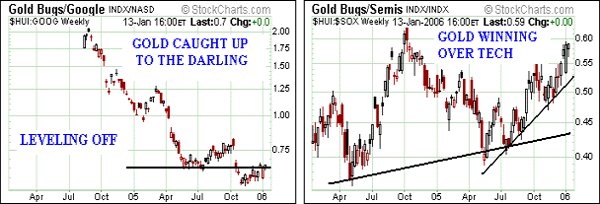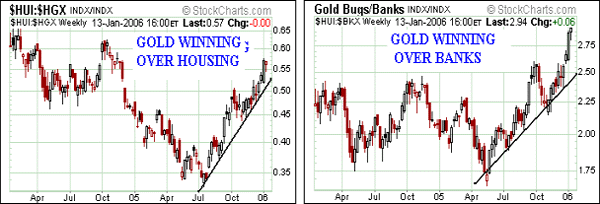XAU/HUI: Response To Wallenwein
In his thought provoking article at the end of December, Alex Wallenwein examines in a coffee table setting the question of why the hedged XAU index broke out well before the unhedged HUI index. His "Why Are Gold Hedgers Winning?" raised many interesting and probing questions, and answered some.
Let's preface with an explanation of hedge practices.Certain gold mining firms became carried away with greed, selling forward their production in the last decade. In doing so, some such firms became at the same time corrupted, were hurt by their greed, and hid their ill-fated maneuvers from their own share holders. They actually morphed into finance firms, profiting heavily from speculative games, selling short the gold metal far in excess of actual production. Such tactics succeeded, as long as the gold price declined. The corrupted priorities, for some aggressive firms, led at times to gigantic short positions on their balance sheets. The HUI was initially hatched out of a desire to point to a stock index uncorrupted by hedge practices. Such "hedged" firms lost large amounts of money in their balance sheets during the rising gold price environment since 2001.
But, but, but the XAU broke out first, four to six weeks before the HUI finally did. How is this? Was is das? Qu'est-ce que c'est? Non comprendo! HUH!!!
Some of Wallenwein's proposed explanations seem very credible. At first glance, major hedged firms might have more production, or the unhedged firms might be shunned by the institutions after bad blood. These are excellent posed arguments. See his article for detailed musings, theories, often leading to further questions. The concept of leverage and liquidity presented by the XAU component stocks adds a bit more to the picture, and might more fully explain the paradox.
The more established (but very much hedged) gold mining stock index XAU broke out emphatically in mid-November, at least one full month ahead of the unhedged gold mining stock index HUI. This has proved a paradox, since one would expect the XAU to be a laggard in any comparative race to break out. Wallenwein purports that perhaps the hedged giants are more adept in exploration, or had production capitalized and much farther along, or possessed reserves more accessible to immediate exploitation (like mothballed mines). He wonders if hedged giants produced more silver as byproduct, credits to offset costs. He raises the question whether the hedged giants have more friends in the established investment community, as the unhedged might have angered the banker crowd by refusing to assist in short selling.
A FRESH EXPLANATION POSED
Here is a fresh explanation, offered without researched proof. It would be nice if somebody could produce some option open interest evidence over time, unavailable to me, not pursued actually. My hypothesis is just that, posed as an afterthought. The XAU offers four large mining stocks (not in HUI) which each trade options. It is widely reported that the speculative crowd, primarily the hedge funds, employed spread trades in gold. They went long the gold metal, and shorted the gold mining stocks. They expected the metal to lead, for whatever reason, on the breakout. Clearly, mining firms must deal with the cost issue, as fuel costs have risen, as construction costs have risen, even property prices have risen. They were proved right, and profited handsomely, if indeed that was the predominant trade.
The hedge fund community likely utilized stock options with their short stock positions in opposition to metal positions. They might have done so as an added "jet assist" to the mining common shares in such a way as to construct equal magnitudes for physical metal versus stock positions in a market environment which lacked the liquidity on the stock side.
Balanced scale in the spread trade is important. When the stock shorts were covered, and the hedge spread trades were unwound, the XAU participated more than the HUI. Options availability dictated that the XAU be used for more leverage and liquidity. We all are very aware of the low liquidity and low market cap for the entire gold mining sector for capitalized stock issuance and trading. Well, this might have proved to be a disadvantage to the big hedge funds when they employed the long physical metal versus short mining stock spread trade. Its makes some sense, but surely requires further verification. The breakout event in the latter months of 2005 proved to be a paradox which will be studied in the future, and talked about for many months to come.
MINING STOCKS MARK A SEA CHANGE
A grand shift is in progress, whereby in the last few months, commodity investment has overwhelmed technology, banking, and housing. This shift is masked by a strong S&P500 index (4-1/2 year high), by a strong Nasdaq composite index (4-1/2 year high), and by some late bursts of apparent strength in housing (strong November housing starts). My preferred tool to demonstrate the transition is again the ratio charts. One year ago, my pen produced an article which correctly heralded a shift in "Oil to Prevail over Gold" wherein another ratio chart signaled clearly a trend unfolding. It proved correct, as energy stocks screamed higher, peaking in springtime.
See the charts of the gold mining index HUI versus Google (GOOG), HUI versus the semiconductor chip index (SOX), HUI versus the banking index (BKX), and HUI versus the home builder index (HGX). In each ratio chart, gold miners have turned the tide, and over recent months have seized a dominant position relative to each of these three important indexes.
Gold has matched the tech darling Google. Stress within the mainstream stock market can be seen with merger mania, which reached $1100 billion in 2005, a 29% rise. This is a signal of a top. Gold has begun to overshadow the manias, or is it the maniacs? At the same time, mergers & acquisitions have become fertile ground for devious but profitable private equity firm fees and payoffs, with the latest technique to saddle the company's balance sheet with new debt when fees are paid out, sometimes in the form of dividends. There is no end to devious financial games and stunts pulled by the US financial firms so as to extract profit, even if at times underhanded. We call it the grand "paper game" among ourselves. It is accounting sleight of hand. After all, a movement is afoot, actually well established, that the US financial sector shows signs of institutionalized dishonesty. Almost every single important USEconomic statistic is replete with deception and lies. Europeans openly talk about it. The movement is so engrained, that US investors accept it as part of the landscape. Gold always benefits in a transition toward improved honesty.

The trend in the last six months is for the HUI gold stock index to outperform the SOX chip index by almost 50%, the technology leading indicator. Look also, the HUI ratio with mighty Google has begun to form a bottom, soon likely to favor gold on an upswing. The Google story is remarkable, no doubt, but needs its own critical flatulence (sulfurous noxious gaseous discharge). Its growth is outstanding, but so is the mania behind it. To grant even this darling a market cap to overshadow so many great large established and tangible companies seems the stuff of manias. The SOX semiconductor index might show fatigue if the consumer movement hits the skids, feels some drag, and is denied its fuel from reduced home equity loans and reduced credit card abuse.
The HUI index has also bested the BKX index by 60%, and outdone the HGX housing index by 70%. A trend change is upon us, favoring gold investments. The new trend is underway, favoring gold and hard money over technology from a gradual economic slowdown harming industrial, automotive, and consumer electronics. The stress to the banking sector is evident with a flat yield curve, from which profit extraction is rendered difficult in the lending business and speculative endeavors. See the JPMorgan quarterly report out yesterday, wherein they admit a 1% loss in interest based lending business. This is stark evidence of the flat yield curve and its negative impact on the lending business. The stress to the housing sector is evident in ultra slow motion, first with signals, later with the reality. Look for the housing hiss of released bubble gas of its own to extend for years.

HARKEN, MY OLD QUALCOMM
As in Dec1999, when Qualcomm was touted with at $1000/share target, here in Jan2006 Piper Jaffrey has touted GOOG shares with a $600/share target. This is the unmistakable signal of a top, surely to be recognized and labeled as obvious in the next 12 to 18 months.Mergers & acquisitions reached a crescendo, boasted as the best year since 1999 & 2000. However, the second shoe in the message is the stock bust linked to that timeframe. Proctor & Gamble acquired Gillette. Boston Scientific is to acquire Guidant, an unending and truly tired meaningless but hardly titillating saga. There was more M&A sillyness, with sectors covering the spectrum in finance, energy, technology, and basic industries. The byline story is false, of synergy and reduced costs to generate topline sales growth. The reality is job loss from streamlined administration, saved costs from shed health benefits and pension obligations, and some outsourced operations. Two years down the road, few if any M&A stories have really lived up to their hype.
Contrary to popular opinion, breakups are much more advantageous. If Time Warner can fully jettison its America Online business unit, both parties will benefit. Bigger is not better. Oligopolies are not better. Efficiency is usually not associated with a few gigantic corporate conglomerates dominate industries, nor is prompt decisiveness. How are GM, Ford, and Chrysler doing? Methinks LOUSY. If the computer industry remained the province battleground for IBM, Digital, Hewlett-Packard, and Compaq, would that sector be as robust and vibrant as it is now? Methinks NO. The catch phrase is "breakups release hidden value." The converse with M&A activity is "mergers smother value." But wait! Wall Street brokerage firms derive hefty fees.
Take a quick look at Japan for another sea change in the making. The Nikkei stock index of 225 large cap Japanese stocks just completed a strange day. They enforced a 20-minute halt to trading, the first in 57 years. Large Japanese stocks (see the Nikkei index chart) have benefited first from the abandoned USTBond in the interrupted recycle process of trade surpluses. The Bank of Japan, focal point for handling trade surpluses, has not added much of any USTBonds holdings since May2005, a story not told in the US lapdog press & media. Also, yen carry trades are being unwound to some extent, as monster profits are locked. Money is staying home, which has pushed the Nikkei index of major Japanese corporations from 12,000 to over 16,000 since its August breakout. That is a tremendous 33% gain. They love bubbles as much as Americans do. Look for more money in Japan heading into gold. They also have a nice gold rally, expressed in yen terms. See the gold yen chart which shows the gold rally in yen denomination, a wicked breakout which preceded the Chinese yuan currency delink in July2005.
THE HAT TRICK LETTER COMBINES MACRO ANALYSIS WITH INVESTMENTS.
From subscribers and readers:
"Please don't change your style because a few people do not have the required attention span for anything more then comic books. I like my JW straight up, not watered down for mass consumption."
(Joel P in Quebec)
"As an aside, I've been managing money for 15 years and have met a number of top minds from Wall Street and I can say that I consider your work exceptional. You've got a terrific way of knitting seemingly unrelated pieces of information into a clear, concise view of the big picture."
(Philip B in New York)
"Jim has a way of cutting through all the fluff and getting right at the heart of things but doing so in a manner that is both easy to understand and fun to read. His work is both original and provocative, and he is one of the few guys out there that I look forward to reading."
(Dan Norcini, commodity trader, NOT a subscriber)
"I just read your latest piece about the yield curve. You are right on the money with pretty much everything you say, as usual. Also, those are good insights [on why the XAU index has jumped before the HUI]."
(Alex Wallenwein, currency analyst, NOT a subscriber)
Jim Willie CB is a statistical analyst in marketing research and retail forecasting. He holds a PhD in Statistics. His career has stretched over 24 years. He aspires to thrive in the financial editor world, unencumbered by the limitations of economic credentials. Visit his free website to find articles from topflight authors at www.GoldenJackass.com. For personal questions about subscriptions, contact him at [email protected]

















